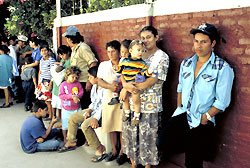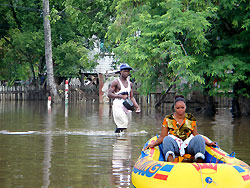 Over the last two decades, disaster mortality statistics have highlighted the need for a gender-based approach that addresses vulnerabilities and strengths of the affected population. Responding to this need, international organizations, NGOs and development agencies have progressively incorporated checklists and recommendations into emergency response actions to achieve two objectives: to identify and assess gender issues that impact women and men in the response and aftermath and to develop guidelines for gender-oriented actions for field planners and responders.
Over the last two decades, disaster mortality statistics have highlighted the need for a gender-based approach that addresses vulnerabilities and strengths of the affected population. Responding to this need, international organizations, NGOs and development agencies have progressively incorporated checklists and recommendations into emergency response actions to achieve two objectives: to identify and assess gender issues that impact women and men in the response and aftermath and to develop guidelines for gender-oriented actions for field planners and responders.
There are a wide array of recommended actions and approaches to address gender-based needs and strengths among the affected population. These documents range from short-term (early recovery) actions to more cross cutting issues, such as checking whether gender roles have changed after the emergency. Yet it has proven difficult to identify and extract the best practices that make a real difference.
A few accounts may help to put this need in perspective. Female deaths in the 2004 tsunami were three to four times higher than those of the male population. The disparity was mainly explained as the result of cultural or economic determinants: in the culture of the affected countries, women often were not taught to swim, which put them at greater risk when the tsunami struck. Ten months later, the earthquake in Pakistan left more than 78,000 dead and 100,000 injured. Three-quarters of the severely injured were women, many of whom suffered spinal cord injuries. A reported 20% of breastfeeding women were unable to take care of their children because of post-traumatic stress.
 These data demonstrate that men and women face different risk factors in emergency situations, yet the many existing recommendations calling for a gender focus in emergencies have been largely ignored. Therefore, before deciding if new guidelines are needed, one should first consider how existing tools are being used. When guidelines are applied without due consideration to cultural, economic and social determinants, they actually may become a barrier to gender-mainstreaming for several reasons.
These data demonstrate that men and women face different risk factors in emergency situations, yet the many existing recommendations calling for a gender focus in emergencies have been largely ignored. Therefore, before deciding if new guidelines are needed, one should first consider how existing tools are being used. When guidelines are applied without due consideration to cultural, economic and social determinants, they actually may become a barrier to gender-mainstreaming for several reasons.
First, relief workers and responders may perceive that the guidelines don’t coincide with field needs and priorities. This disconnect between policy, strategy and implementation can affect whether or not a gender approach is integrated into current and future programs at the field and community level. Secondly, a gender focus may be translated into action only through “spot” interventions because of the short timeframe in response and early recovery. Follow up to these interventions is unlikely. Finally, local communities may perceive that a gender focus is just one additional task imposed on them by the international community, leading to rejection by the local stakeholders themselves.
How can gender-focused guidelines promote mainstreaming of the topic? One way is to avoid duplication of information. An overabundance of guidelines causes confusion at the implementation level, as workers do not know which guidelines to follow. Duplication of information also prevents community decision makers from understanding to what extent the guidelines should be applied to resolve gender-based issues. Community decision makers must be involved in adjusting them to specific health and socioeconomic determinants in each emergency and discussing their feasibility. Additionally, guidelines should address gender-specific needs during the preparedness phase (before an emergency even occurs). Finally, both decision makers and implementers should be encouraged to implement long-term gender-based guidelines in their program planning.
This article was prepared by PAHO/WHO’s Gender, Ethnicity and Health Unit. For more information, contact Elsa Gomez, This email address is being protected from spambots. You need JavaScript enabled to view it..
